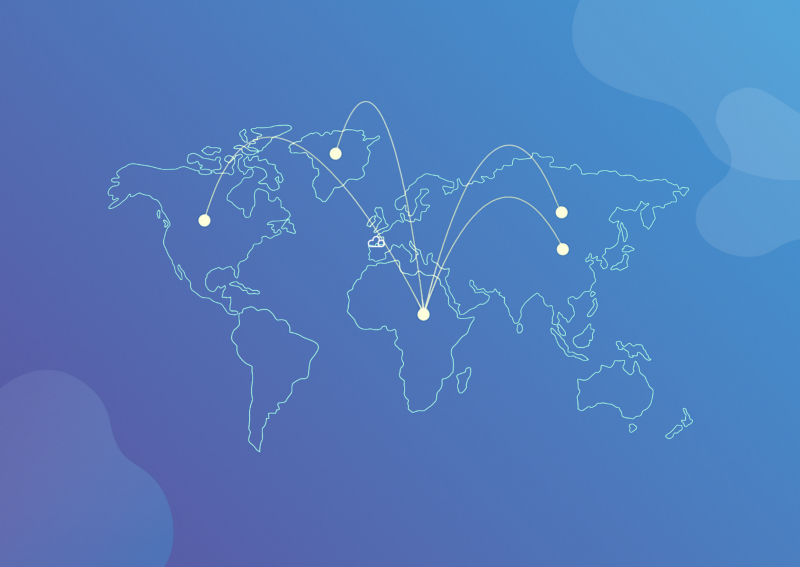






How the evolution of technology has helped connect the world

Connecting the world in a fast and effective way has been a key concern of visionary people for a long time. Remote and immediate communication between people took its first steps with the telegraph and telephone in the 19th century. However, it would be during the 20th century when the telecommunications phenomenon would advance with great speed. Leaving in its wake current inventions such as radio, television, mobile telephony… and the Internet.
Recently, the video calls we enjoy today were a figment of writers and screenwriters of science fiction movies and comics imagination. Nowadays social networks and streaming are part of an evolving reality. Join us on this brief historical tour of human communication!
The telegraph, faster than the mail to connect the world
In reality, the telegraph did not have a single inventor. In parallel, two groups of scientists worked on both sides of the Atlantic on similar developments during the 1830s. On the one hand, William Cooke and Charles Wheatstone in England. Very soon, their first equipment began to be used in British railway signaling.
Meanwhile, in the United States, Samuel Morse was taking the first steps to create his version of the telegraph. Together with Alfred Vail and Leonard Gale, he produced a system that completed the electrical circuit each time the operator pressed the dial key. This produced an electrical signal that traveled along a wire to a receiving device at the other end.
A revolutionary code
Morse and Vail perfected a code to identify the letters of the alphabet and numbers. For this purpose, they assigned to each letter and number a set of dots and dashes (short and long marks with the key). This is what is now historically known as Morse Code.
On May 24, 1844, Morse sent the first official message using this telegraph system. He was in Washington D.C. and Vail, the receiver, in Baltimore, Maryland. Later, the invention would be enriched by the contributions of Ezra Cornell and Thomas Alva Edison.
By 1861, the Western Union Telegraphy Company, owned by Cornell, became the first nationwide telegraph company. Undoubtedly, the telegraph allowed faster transmission of messages over distance, surpassing the mail that traveled by railroad and horse-drawn stagecoaches. This changed the operability of sectors such as the military and journalism. It also influenced the economy, as it allowed the first long-distance money transfers. In short, it was a breakthrough in connecting the world.
The telephone, a technology that has been evolving for 170 years to connect the world
32 years after Morse’s first telegraph message, two inventors were vying for the creation of another revolutionary communication system. Within hours of each other, Alexander Graham Bell and Elisha Gray, in that order, patented their telephones. However, Bell ended up winning a legal dispute over the originality of the invention. For this reason, we believed for a long time that the Scottish scientist, who emigrated to the U.S., was its legitimate author.
But surprisingly the truth is that the first pair of telephones were created by the Italian inventor living in New York, Antonio Meucci in 1854. Unlike Bell, the Italian had no money to patent the prodigy.This is so true, that the U.S. Congress itself would end up recognizing Meucci’s merit in 2002.
Radio, another way to connect the world
Even in the full consolidation of the telegraph and telephone, several scientists wanted to go further. That is, to transmit messages between distant points without using wires. As early as 1865, the Scottish physicist James Clerk Maxwell published his Theory of the Electromagnetic Field. In it he determined that electric and magnetic fields travel through space at a speed similar to that of light.
Based on this principle, the German scientist Heinrich Rudolf Hertz would discover, twenty years later, the way to produce and capture these electromagnetic waves. He also demonstrated with experiments the travel of these waves through the air, ratifying Maxwell’s theory. In his honor, the unit of frequency in telecommunications was named Hertz or hertz (Hz).
The beginnings of radio
All of the above discoveries prompted the first experiments in wireless telegraphy,which are the forerunner of the radio. An invention attributed to several creators. Starting with the Italian Guglielmo Marconi, who in 1895 developed a transmitter inspired by Hertz’s experiments, with which he managed to transmit signals to a receiver located two kilometers away. Even so, the prodigy did not attract the attention of the Italian government, so Marconi left for England. There he founded the Wireless Telegraph and Signal Company.
In 1899, Marconi demonstrated his devices by achieving a 48 km transmission between Dover (UK) and Boulounge (France). Two years later, he was able to transmit a signal 3,400 km across the Atlantic Ocean. He would later establish the first commercial transatlantic wireless telegraph service between Ireland and Canada. The Italian scientist managed to enter the U.S. market, although he was not recognized there as the creator of the invention.
Is the invention Tesla’s?
On the other hand, many specialists claim that Nicola Tesla invented a wireless message transmission system in 1895. And therefore Marconi went ahead, patenting it and using it in his 1899 experiments. The U.S. Supreme Court eventually recognized Tesla as the rightful creator of the invention in 1943.
All these advances laid the foundations for today’s radio communication, which is vital in military, public and private security operations. But also for emergency services. As well as for various productive sectors such as aviation, mining and construction, among many others. Obviously, they also influenced broadcasting as a means of information and entertainment to connect the world.
Television, the transmission of image and sound to connect the world
Television is also an invention with a long history. The first technologies aimed at transmitting images and reproducing them on a remote receiver emerged in the late 19th century.
John Logie Baird in the United Kingdom developed a television system that could transmit images over short distances, which he tested in 1926. A year later he was able to transmit them over a telephone line between London and Glasgow. And in 1928, he succeeded in transmitting television signals from London to New York.
The first transmissions
Using the system perfected by Baird, the BBC in London began its first official television transmissions on September 30, 1929. And on December 31, 1930, it would make the first simultaneous broadcast of image and sound. This was a milestone for the recently launched invention. Also in 1930, in the United States, the legendary CBS and NBC networks would do the same with the systems developed in the country.
This was followed by continuous improvements in the resolution of transmissions, color and many other advances in broadcasting and receivers. In this way, television became one of the most influential information and entertainment media in the following decades.
Unlimited innovation to connect the world
In the last 50 years, technological evolution has been unstoppable. Thanks to the development of microprocessors in the early 1970s, personal computers began to become popular. Computing was no longer the exclusive preserve of large companies, government agencies or scientific institutes. We could find them in homes and offices, making them more accessible to many more users. As if that were not enough, the next big thing would change the way the world was connected in the following decade; mobile telephony burst onto the scene commercially in the early 1980s and would evolve at breakneck speed as well.
Mobile telephony
To mention all the milestones in the evolution of this invention would take much more time. However, it is impossible to ignore the breakthrough that mobile telephony meant in its function to connect the world. As a precedent, there is the historic call of April 3, 1973, made by Martin Cooper, a Motorola executive, from a New York street. Using the DynaTAC 8000X, the first cell phone in history, he communicated with Joel Engel of Bell Laboratories, his competitor… Motorola beat the veteran Bell in this challenge.
But the device would not go on sale until 1983. To tell the truth, it was not at all practical in today’s perspective. It looked like a brick at 33 x 4.4 x 8.9 cm and weighed one kilogram. In the same year, Ameritech Mobile Communications, the first U.S. company to provide cell phone service to the public, began operations.
With the development of the GSM 2G standard in the early 1990s, mobile telephony would advance unstoppably in capacity and functionality.
WWW, the democratization of the Internet to connect the world
In the early 1990s, the launch of the World Wide Web project began to facilitate public access to the Internet. Previously, the use of the Internet as a form of communication between networked computers was reserved for military, educational and scientific institutions. The WWW was created in 1989 by British physicist Tim Berners-Lee at the European Particle Physics Laboratory, CERN.
In addition, Berners-Lee developed a first search engine in order to facilitate access to the WWW from personal computers. The latter program was replaced in 1993 by Mosaic, created at the University of Illinois. But the emergence of search engines contributed decisively to the popularization of the Internet.
Similarly, with the creation of web pages, many companies began to have a presence on the network. As a result, the Internet was becoming attractive as a marketing channel. E-mail also became a tool for communication between people and organizations.
Today, the conventional media are turning to the Internet in order to offer an added value to their users. Newspapers have web portals, TV stations and broadcasters share content on networks such as YouTube and podcast platforms. On the other hand, there are paid digital native media that offer a variety of content. Among them are streaming platforms such as Netflix.
Ecommerce changes the way we shop
As the design of web pages began to be enriched with multimedia content, the initiative to sell online emerged. Companies that practiced traditional sales through printed catalogs or telesales programs on television would find a strong competitor in ecommerce. In 1995, two iconic online commerce platforms appeared: eBay and Amazon. A couple of years later, the technology company Dell surpassed one million dollars in online sales. Online payment platforms such as PayPal would soon appear as an alternative to credit cards.
Social networks, another way to connect the world
At first, social networks served as a space for old friends to meet up. Nowadays, social networks are the space for interaction par excellence between acquaintances and strangers. Through them, we share content in various formats, we learn about details that go beyond the news on news portals. We even share professional interests, look for jobs… and even shop. By now, more than half of the world’s population is a user of social networks!
Among the first platforms were Sixdegrees (1997), Friendster (2002), Myspace and the current professional network LinkedIn (2003). Shortly after, Facebook (2004), the current leader in number of users, YouTube (2005), Twitter (2006) and Whatsapp (2009) emerged. Although Whatsapp is still considered a messaging platform, it is one of the most versatile and widely used social interaction channels. The list continues with: Instagram and Pinterest (2010), Google+ (Google’s failed experiment, in 2011) and TikTok (2016). And these are just the most popular!
Mobile networks and devices
From the very basics, mobile networks evolved to connect the world from portable devices. The early 1G, based on a frequency modulated (FM) transmission system, was slow and unstable. On the other hand, the 2G successor was associated with the new GSM standard and SIM cards, where personal and device information was recorded. It was faster and allowed sending and receiving from SMS to sending emails.
Shortly thereafter, the advance and popularity of the Internet called for an upgrade to 2G. An “intermediate generation”, 2.5G, solved part of the problem in 2001. With it, the Internet reached cell phones with most of its possibilities. As a result, the speed improved. Almost immediately, the third generation of 3G and its intermediates arrived, making the unimaginable possible. In particular, it became possible to watch and record videos, hold video conferences and even take photos with good resolution. In the midst of their leadership, touchscreen smartphones emerged, bringing significant physical and functional changes. And we say leadership, because it is still in force, despite the emergence of 4G in 2009. With the fourth generation, connectivity and devices enabled file upload and download speeds of up to 150 Mbps — ten times faster than 3G!
5G is already a reality. At least in Spain, the first networks were established in 2019. Above and beyond the high speeds offered by this connectivity technology, there is the possibility of making greater use of advances such as the Internet of Things IoT, Artificial Intelligence and Big Data.
Mobile apps
The first mobile apps would come embedded in our devices during the 1990s. In themselves, they made up the functionalities of many phones: agenda, calendar, games, etc. In 2000, WAP (Wireless Application Protocol) technology already allowed access to small versions of web pages. As well as sending and receiving emails and reading news.
But the big breakthrough for mobile applications came with the introduction of Apple’s first iPhone in 2007. With the capacity of this device it was possible to download the applications that the user required for work, entertainment or shopping. As a result, the Apple company opened its virtual app store, AppStore, the following year. In 2008, Google responded with the launch of its HTC Dream, or GMobile, with its Android operating system. And it would immediately open its app store, today known as PlayStore.
Connecting the world is part of our mission at Nuvolar.
Throughout this brief summary, you have seen how the technologies described above have impacted the way we connect the world. Reaching today’s communication systems with their enormous potential is the product of a relentless pursuit to achieve an increasingly effective interaction between people. This continuous change of standards makes users’ expectations and demands evolve as well.
This is the main reason why at at Nuvolar we insist on providing user experiences that exceed the expectations of those who browse the websites, environments and applications we design. For us, UX and UI are essential and we apply them thoroughly in every project we take on.
We love what we do and it shows in the results of our work! Would you like to know how we can improve your company’s online presence? Contact us!
About Nuvolar:
We are a digital innovation consulting company dedicated to one unique purpose: helping businesses adopt world-class software solutions on the cloud so they can succeed!








